HRMM058: Cross-Cultural Management and Starbucks' Global Operations
VerifiedAdded on 2022/10/04
|20
|2228
|67
Report
AI Summary
This report provides an in-depth analysis of cross-cultural management (CCM) practices within Starbucks, exploring its application in a global context. The report begins with an introduction to CCM, emphasizing its significance in managing diverse work environments and enhancing customer relations. A literature review examines the impact of cultural diversity on global business operations, highlighting the importance of cultural sensitivity, communication, and understanding cultural dimensions. The report then delves into the relevance of CCM for Starbucks, considering its organizational culture and the challenges of operating in various international markets. Key components discussed include Hofstede's cultural dimensions, the importance of cultural intelligence, and the issues faced when implementing CCM, such as ethical conflicts and communication barriers. Recommendations for improvement include training workshops, strict policies, and effective team management. The report concludes with a gap analysis, identifying the discrepancies between strategic initiatives and implementation processes, and suggesting strategies for enhancing CCM within Starbucks, emphasizing the need for effective human resource initiatives and ethical policies.

Cross cultural
management in
Starbucks
management in
Starbucks
Paraphrase This Document
Need a fresh take? Get an instant paraphrase of this document with our AI Paraphraser
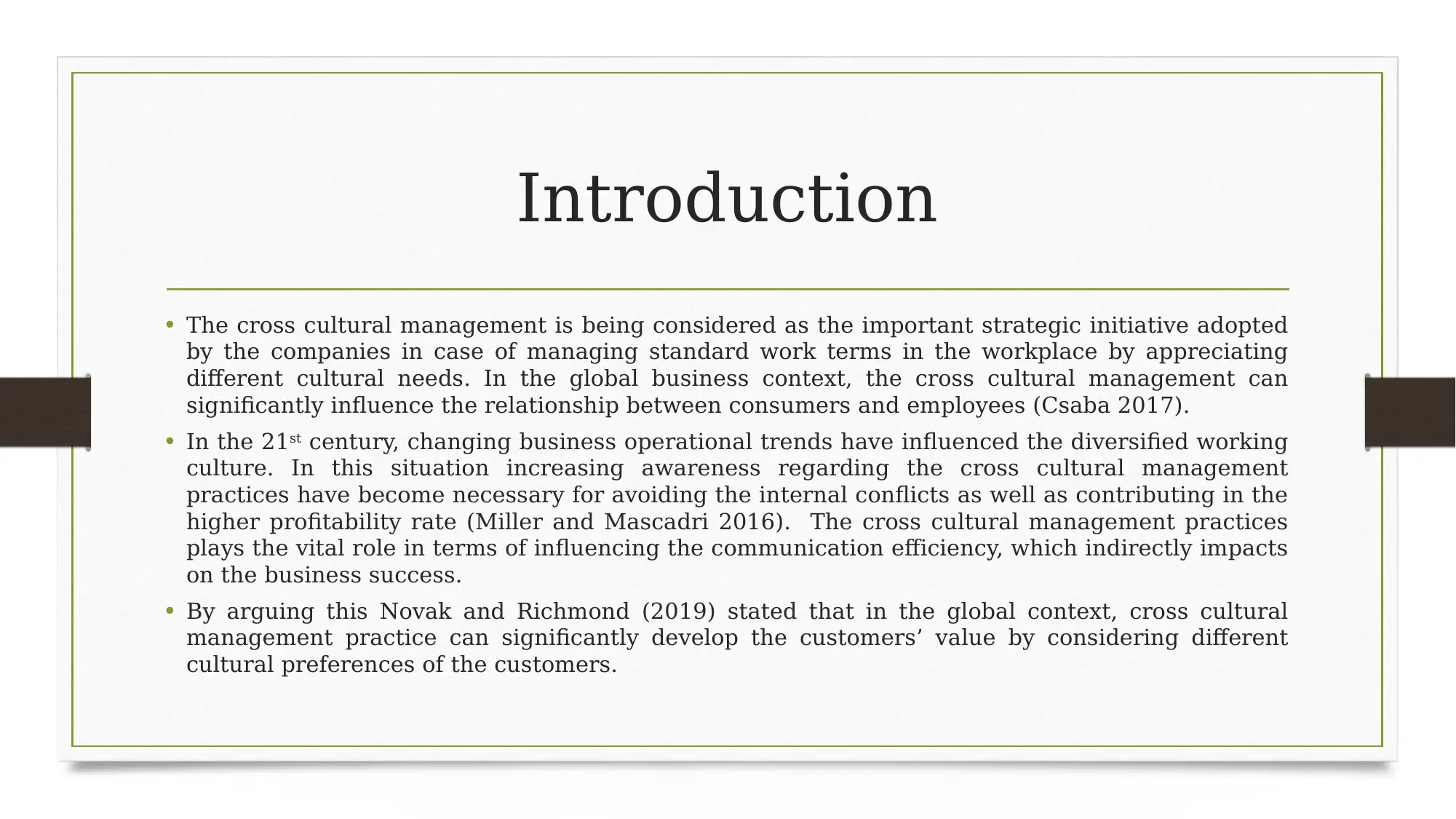
Introduction
• The cross cultural management is being considered as the important strategic initiative adopted
by the companies in case of managing standard work terms in the workplace by appreciating
different cultural needs. In the global business context, the cross cultural management can
significantly influence the relationship between consumers and employees (Csaba 2017).
• In the 21st century, changing business operational trends have influenced the diversified working
culture. In this situation increasing awareness regarding the cross cultural management
practices have become necessary for avoiding the internal conflicts as well as contributing in the
higher profitability rate (Miller and Mascadri 2016). The cross cultural management practices
plays the vital role in terms of influencing the communication efficiency, which indirectly impacts
on the business success.
• By arguing this Novak and Richmond (2019) stated that in the global context, cross cultural
management practice can significantly develop the customers’ value by considering different
cultural preferences of the customers.
• The cross cultural management is being considered as the important strategic initiative adopted
by the companies in case of managing standard work terms in the workplace by appreciating
different cultural needs. In the global business context, the cross cultural management can
significantly influence the relationship between consumers and employees (Csaba 2017).
• In the 21st century, changing business operational trends have influenced the diversified working
culture. In this situation increasing awareness regarding the cross cultural management
practices have become necessary for avoiding the internal conflicts as well as contributing in the
higher profitability rate (Miller and Mascadri 2016). The cross cultural management practices
plays the vital role in terms of influencing the communication efficiency, which indirectly impacts
on the business success.
• By arguing this Novak and Richmond (2019) stated that in the global context, cross cultural
management practice can significantly develop the customers’ value by considering different
cultural preferences of the customers.
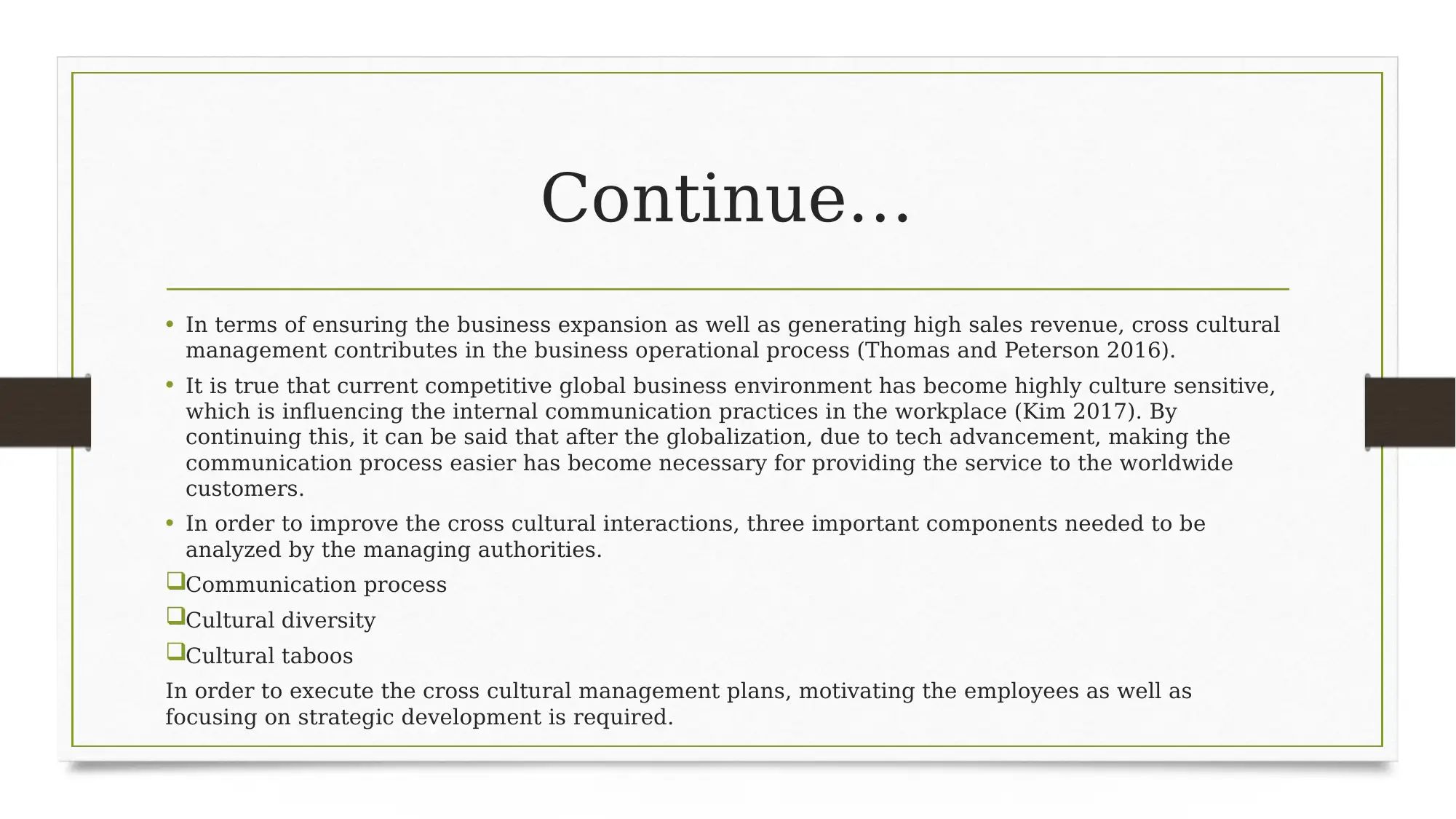
Continue…
• In terms of ensuring the business expansion as well as generating high sales revenue, cross cultural
management contributes in the business operational process (Thomas and Peterson 2016).
• It is true that current competitive global business environment has become highly culture sensitive,
which is influencing the internal communication practices in the workplace (Kim 2017). By
continuing this, it can be said that after the globalization, due to tech advancement, making the
communication process easier has become necessary for providing the service to the worldwide
customers.
• In order to improve the cross cultural interactions, three important components needed to be
analyzed by the managing authorities.
Communication process
Cultural diversity
Cultural taboos
In order to execute the cross cultural management plans, motivating the employees as well as
focusing on strategic development is required.
• In terms of ensuring the business expansion as well as generating high sales revenue, cross cultural
management contributes in the business operational process (Thomas and Peterson 2016).
• It is true that current competitive global business environment has become highly culture sensitive,
which is influencing the internal communication practices in the workplace (Kim 2017). By
continuing this, it can be said that after the globalization, due to tech advancement, making the
communication process easier has become necessary for providing the service to the worldwide
customers.
• In order to improve the cross cultural interactions, three important components needed to be
analyzed by the managing authorities.
Communication process
Cultural diversity
Cultural taboos
In order to execute the cross cultural management plans, motivating the employees as well as
focusing on strategic development is required.
⊘ This is a preview!⊘
Do you want full access?
Subscribe today to unlock all pages.

Trusted by 1+ million students worldwide
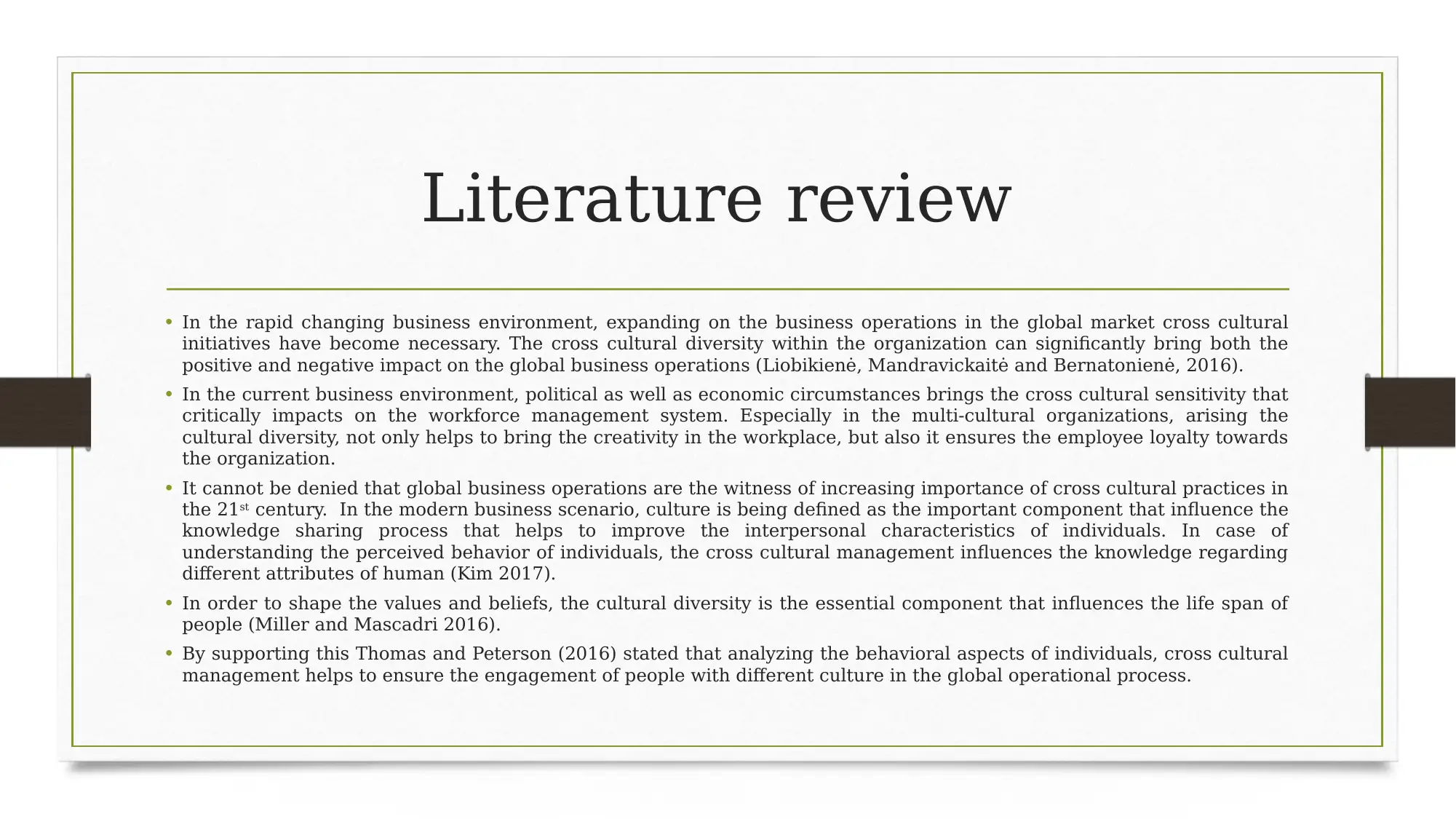
Literature review
• In the rapid changing business environment, expanding on the business operations in the global market cross cultural
initiatives have become necessary. The cross cultural diversity within the organization can significantly bring both the
positive and negative impact on the global business operations (Liobikienė, Mandravickaitė and Bernatonienė, 2016).
• In the current business environment, political as well as economic circumstances brings the cross cultural sensitivity that
critically impacts on the workforce management system. Especially in the multi-cultural organizations, arising the
cultural diversity, not only helps to bring the creativity in the workplace, but also it ensures the employee loyalty towards
the organization.
• It cannot be denied that global business operations are the witness of increasing importance of cross cultural practices in
the 21st century. In the modern business scenario, culture is being defined as the important component that influence the
knowledge sharing process that helps to improve the interpersonal characteristics of individuals. In case of
understanding the perceived behavior of individuals, the cross cultural management influences the knowledge regarding
different attributes of human (Kim 2017).
• In order to shape the values and beliefs, the cultural diversity is the essential component that influences the life span of
people (Miller and Mascadri 2016).
• By supporting this Thomas and Peterson (2016) stated that analyzing the behavioral aspects of individuals, cross cultural
management helps to ensure the engagement of people with different culture in the global operational process.
• In the rapid changing business environment, expanding on the business operations in the global market cross cultural
initiatives have become necessary. The cross cultural diversity within the organization can significantly bring both the
positive and negative impact on the global business operations (Liobikienė, Mandravickaitė and Bernatonienė, 2016).
• In the current business environment, political as well as economic circumstances brings the cross cultural sensitivity that
critically impacts on the workforce management system. Especially in the multi-cultural organizations, arising the
cultural diversity, not only helps to bring the creativity in the workplace, but also it ensures the employee loyalty towards
the organization.
• It cannot be denied that global business operations are the witness of increasing importance of cross cultural practices in
the 21st century. In the modern business scenario, culture is being defined as the important component that influence the
knowledge sharing process that helps to improve the interpersonal characteristics of individuals. In case of
understanding the perceived behavior of individuals, the cross cultural management influences the knowledge regarding
different attributes of human (Kim 2017).
• In order to shape the values and beliefs, the cultural diversity is the essential component that influences the life span of
people (Miller and Mascadri 2016).
• By supporting this Thomas and Peterson (2016) stated that analyzing the behavioral aspects of individuals, cross cultural
management helps to ensure the engagement of people with different culture in the global operational process.
Paraphrase This Document
Need a fresh take? Get an instant paraphrase of this document with our AI Paraphraser
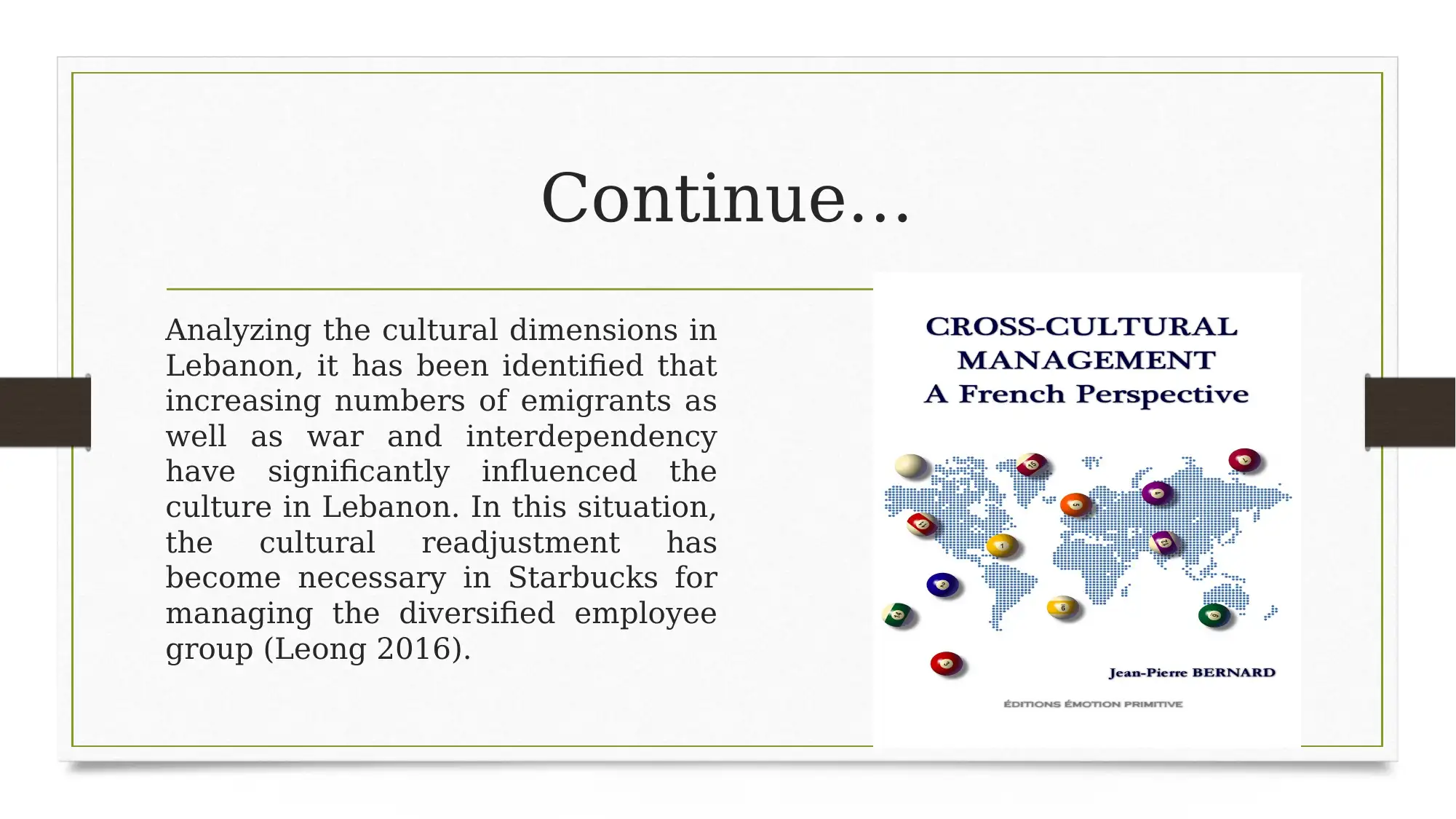
Continue…
Analyzing the cultural dimensions in
Lebanon, it has been identified that
increasing numbers of emigrants as
well as war and interdependency
have significantly influenced the
culture in Lebanon. In this situation,
the cultural readjustment has
become necessary in Starbucks for
managing the diversified employee
group (Leong 2016).
Analyzing the cultural dimensions in
Lebanon, it has been identified that
increasing numbers of emigrants as
well as war and interdependency
have significantly influenced the
culture in Lebanon. In this situation,
the cultural readjustment has
become necessary in Starbucks for
managing the diversified employee
group (Leong 2016).
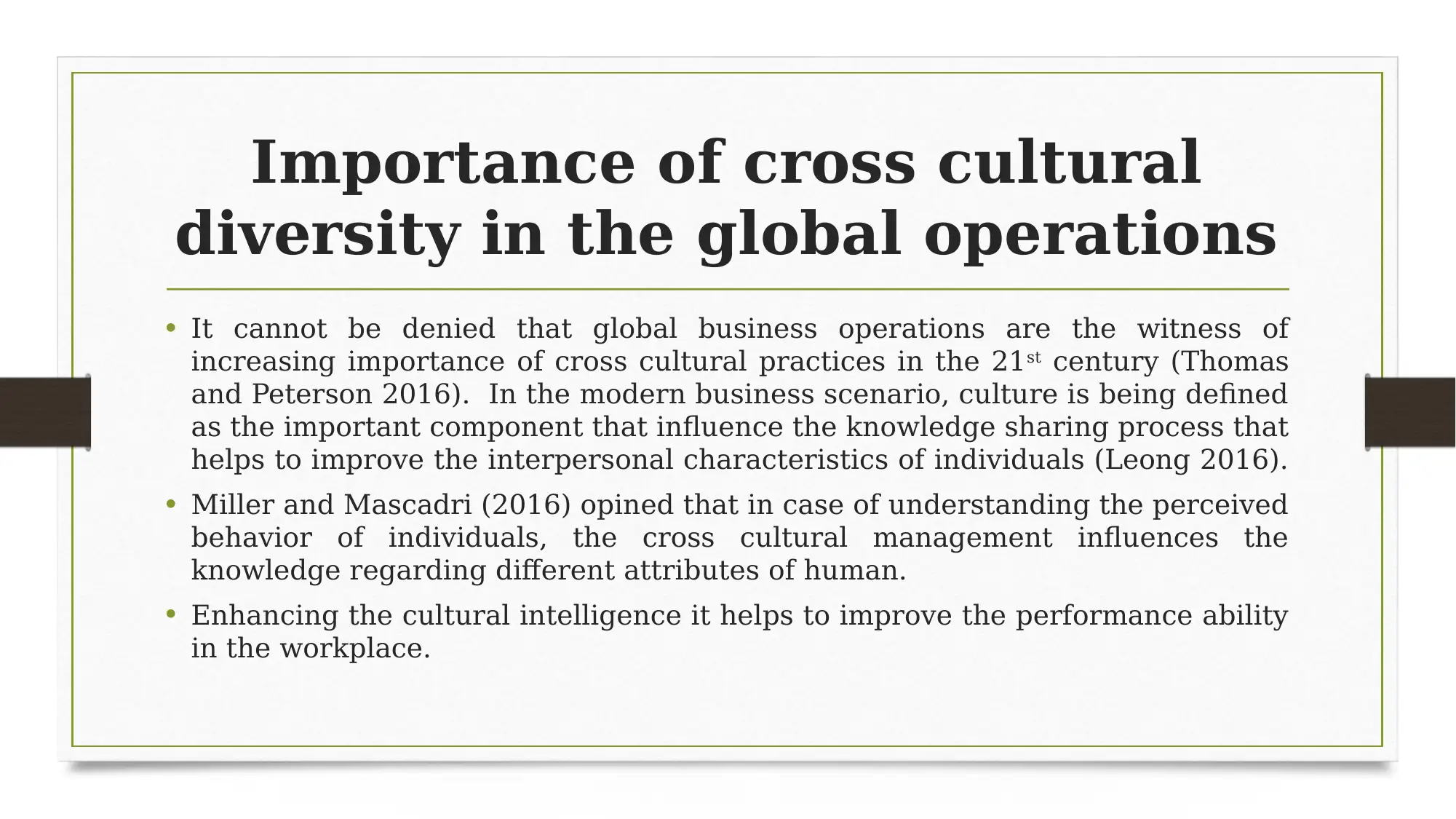
Importance of cross cultural
diversity in the global operations
• It cannot be denied that global business operations are the witness of
increasing importance of cross cultural practices in the 21st century (Thomas
and Peterson 2016). In the modern business scenario, culture is being defined
as the important component that influence the knowledge sharing process that
helps to improve the interpersonal characteristics of individuals (Leong 2016).
• Miller and Mascadri (2016) opined that in case of understanding the perceived
behavior of individuals, the cross cultural management influences the
knowledge regarding different attributes of human.
• Enhancing the cultural intelligence it helps to improve the performance ability
in the workplace.
diversity in the global operations
• It cannot be denied that global business operations are the witness of
increasing importance of cross cultural practices in the 21st century (Thomas
and Peterson 2016). In the modern business scenario, culture is being defined
as the important component that influence the knowledge sharing process that
helps to improve the interpersonal characteristics of individuals (Leong 2016).
• Miller and Mascadri (2016) opined that in case of understanding the perceived
behavior of individuals, the cross cultural management influences the
knowledge regarding different attributes of human.
• Enhancing the cultural intelligence it helps to improve the performance ability
in the workplace.
⊘ This is a preview!⊘
Do you want full access?
Subscribe today to unlock all pages.

Trusted by 1+ million students worldwide
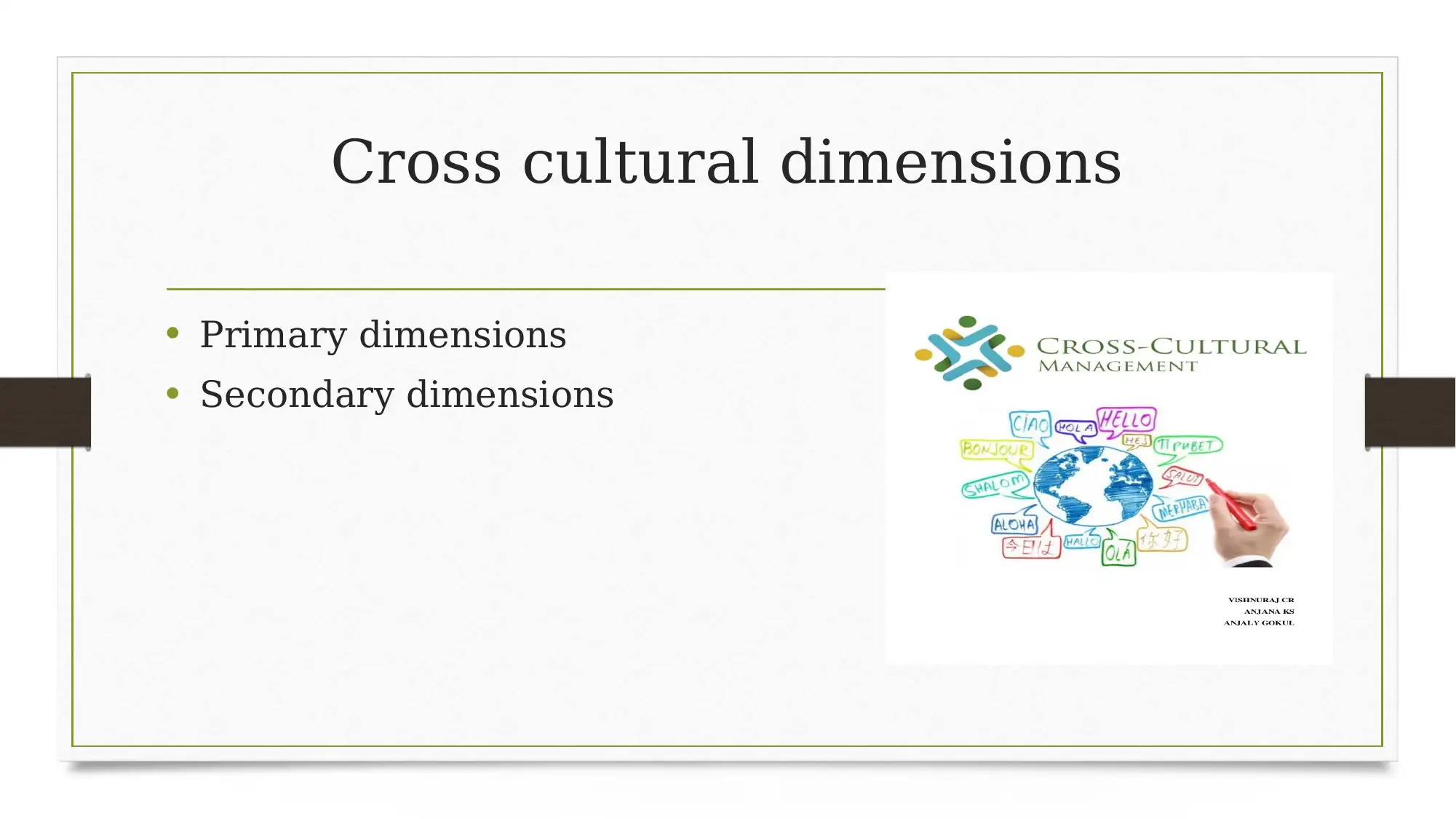
Cross cultural dimensions
• Primary dimensions
• Secondary dimensions
• Primary dimensions
• Secondary dimensions
Paraphrase This Document
Need a fresh take? Get an instant paraphrase of this document with our AI Paraphraser
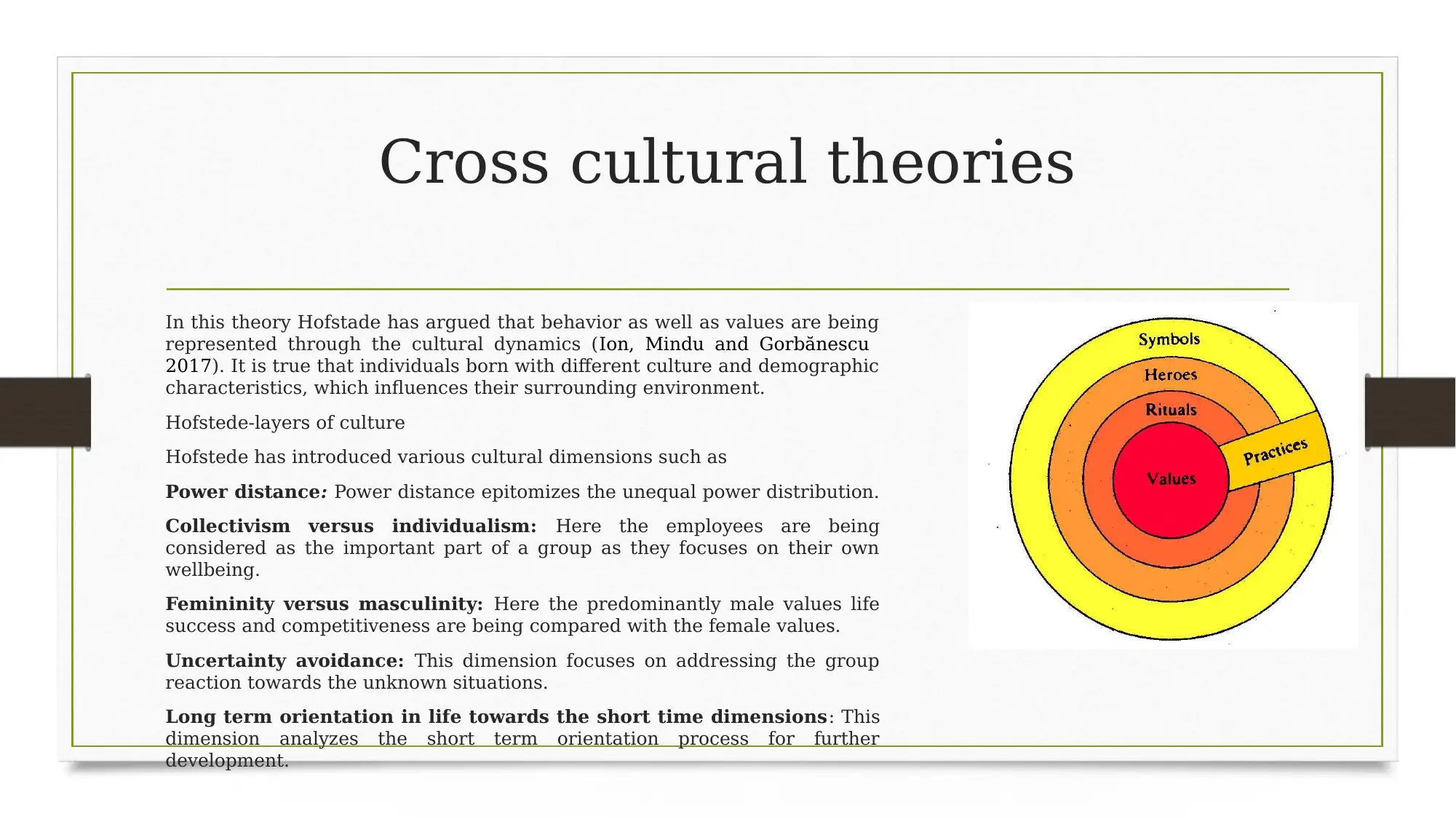
Cross cultural theories
In this theory Hofstade has argued that behavior as well as values are being
represented through the cultural dynamics (Ion, Mindu and Gorbănescu
2017). It is true that individuals born with different culture and demographic
characteristics, which influences their surrounding environment.
Hofstede-layers of culture
Hofstede has introduced various cultural dimensions such as
Power distance: Power distance epitomizes the unequal power distribution.
Collectivism versus individualism: Here the employees are being
considered as the important part of a group as they focuses on their own
wellbeing.
Femininity versus masculinity: Here the predominantly male values life
success and competitiveness are being compared with the female values.
Uncertainty avoidance: This dimension focuses on addressing the group
reaction towards the unknown situations.
Long term orientation in life towards the short time dimensions: This
dimension analyzes the short term orientation process for further
development.
In this theory Hofstade has argued that behavior as well as values are being
represented through the cultural dynamics (Ion, Mindu and Gorbănescu
2017). It is true that individuals born with different culture and demographic
characteristics, which influences their surrounding environment.
Hofstede-layers of culture
Hofstede has introduced various cultural dimensions such as
Power distance: Power distance epitomizes the unequal power distribution.
Collectivism versus individualism: Here the employees are being
considered as the important part of a group as they focuses on their own
wellbeing.
Femininity versus masculinity: Here the predominantly male values life
success and competitiveness are being compared with the female values.
Uncertainty avoidance: This dimension focuses on addressing the group
reaction towards the unknown situations.
Long term orientation in life towards the short time dimensions: This
dimension analyzes the short term orientation process for further
development.
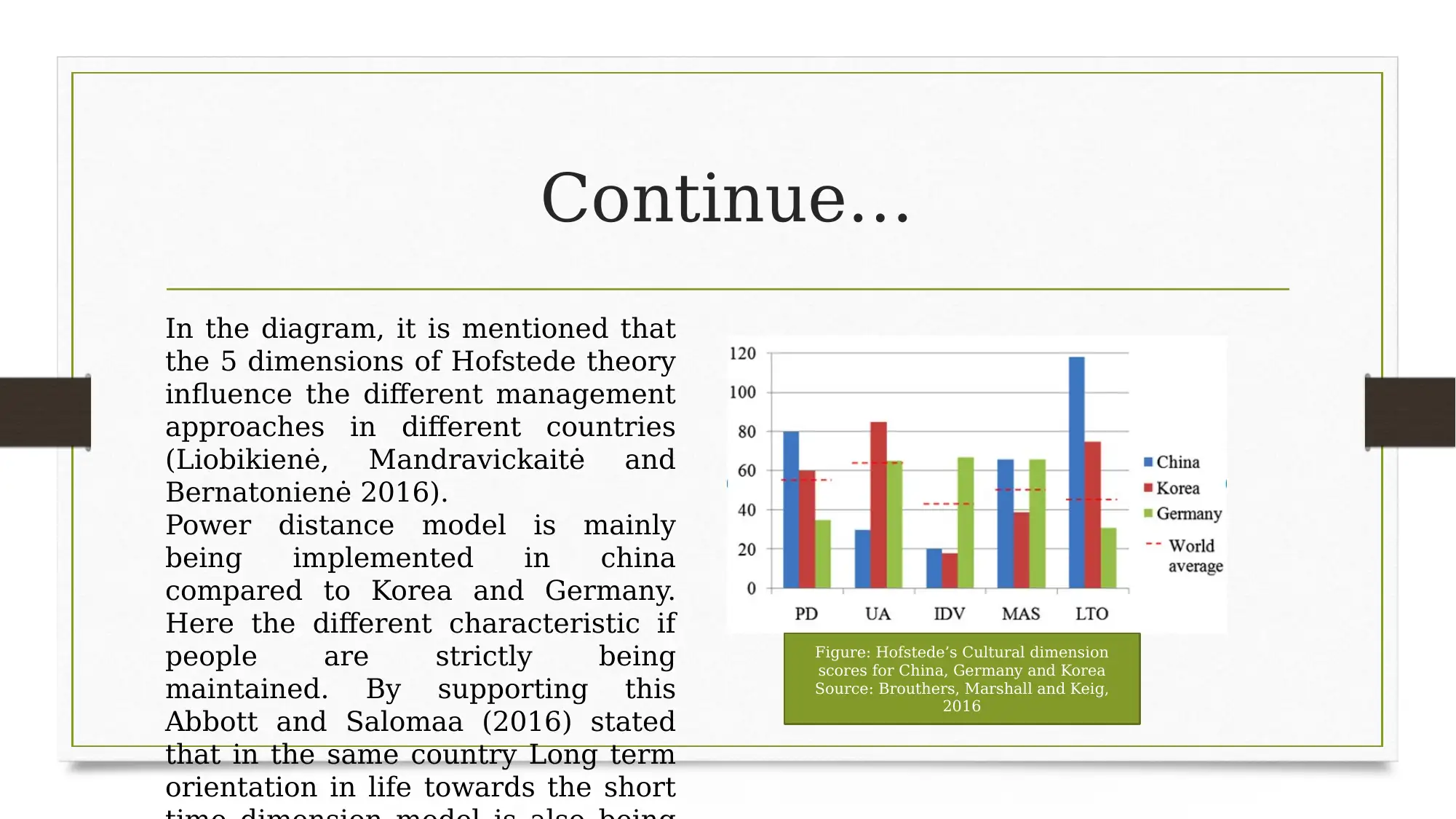
Continue…
In the diagram, it is mentioned that
the 5 dimensions of Hofstede theory
influence the different management
approaches in different countries
(Liobikienė, Mandravickaitė and
Bernatonienė 2016).
Power distance model is mainly
being implemented in china
compared to Korea and Germany.
Here the different characteristic if
people are strictly being
maintained. By supporting this
Abbott and Salomaa (2016) stated
that in the same country Long term
orientation in life towards the short
Figure: Hofstede’s Cultural dimension
scores for China, Germany and Korea
Source: Brouthers, Marshall and Keig,
2016
In the diagram, it is mentioned that
the 5 dimensions of Hofstede theory
influence the different management
approaches in different countries
(Liobikienė, Mandravickaitė and
Bernatonienė 2016).
Power distance model is mainly
being implemented in china
compared to Korea and Germany.
Here the different characteristic if
people are strictly being
maintained. By supporting this
Abbott and Salomaa (2016) stated
that in the same country Long term
orientation in life towards the short
Figure: Hofstede’s Cultural dimension
scores for China, Germany and Korea
Source: Brouthers, Marshall and Keig,
2016
⊘ This is a preview!⊘
Do you want full access?
Subscribe today to unlock all pages.

Trusted by 1+ million students worldwide
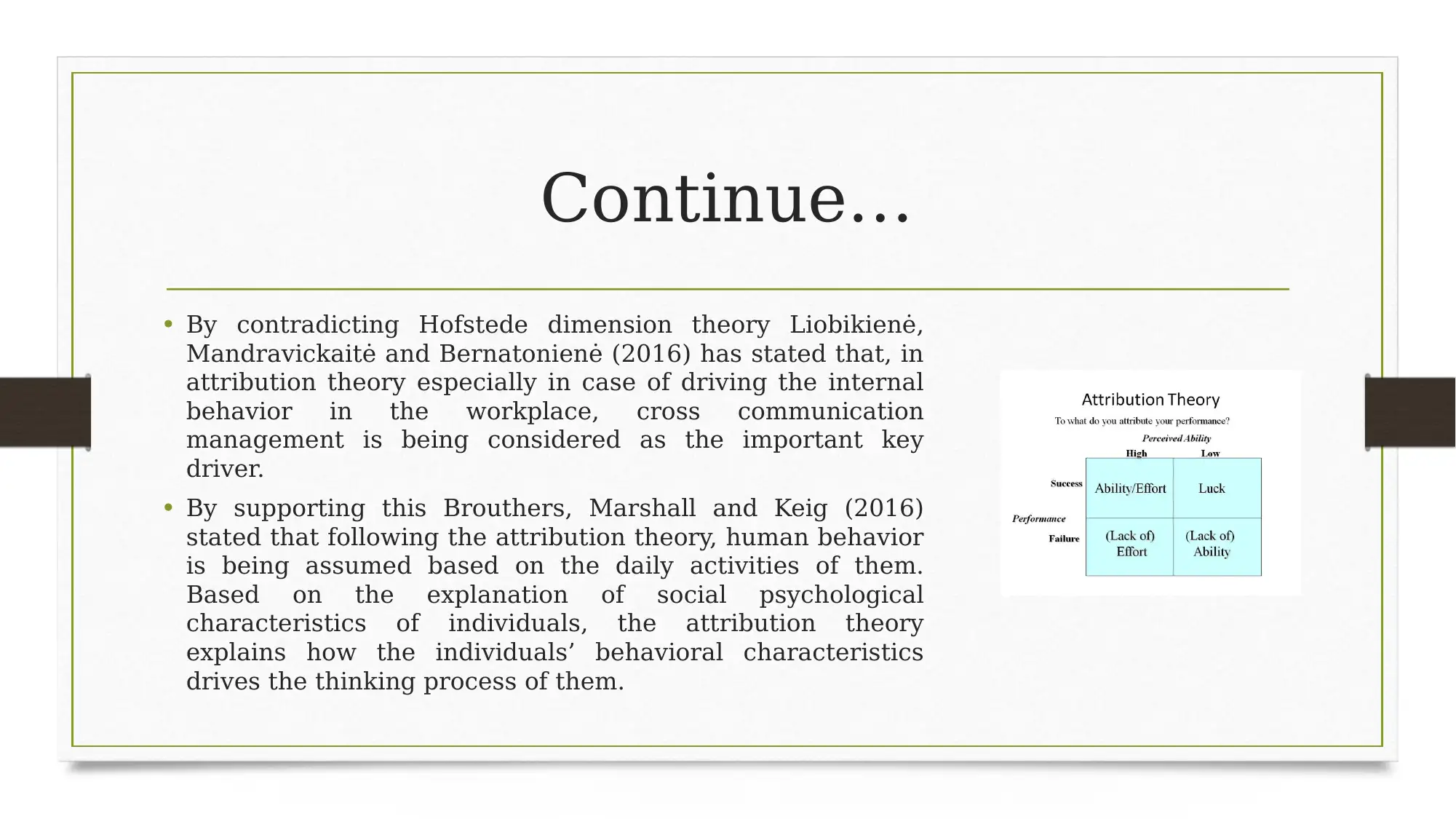
Continue…
• By contradicting Hofstede dimension theory Liobikienė,
Mandravickaitė and Bernatonienė (2016) has stated that, in
attribution theory especially in case of driving the internal
behavior in the workplace, cross communication
management is being considered as the important key
driver.
• By supporting this Brouthers, Marshall and Keig (2016)
stated that following the attribution theory, human behavior
is being assumed based on the daily activities of them.
Based on the explanation of social psychological
characteristics of individuals, the attribution theory
explains how the individuals’ behavioral characteristics
drives the thinking process of them.
• By contradicting Hofstede dimension theory Liobikienė,
Mandravickaitė and Bernatonienė (2016) has stated that, in
attribution theory especially in case of driving the internal
behavior in the workplace, cross communication
management is being considered as the important key
driver.
• By supporting this Brouthers, Marshall and Keig (2016)
stated that following the attribution theory, human behavior
is being assumed based on the daily activities of them.
Based on the explanation of social psychological
characteristics of individuals, the attribution theory
explains how the individuals’ behavioral characteristics
drives the thinking process of them.
Paraphrase This Document
Need a fresh take? Get an instant paraphrase of this document with our AI Paraphraser
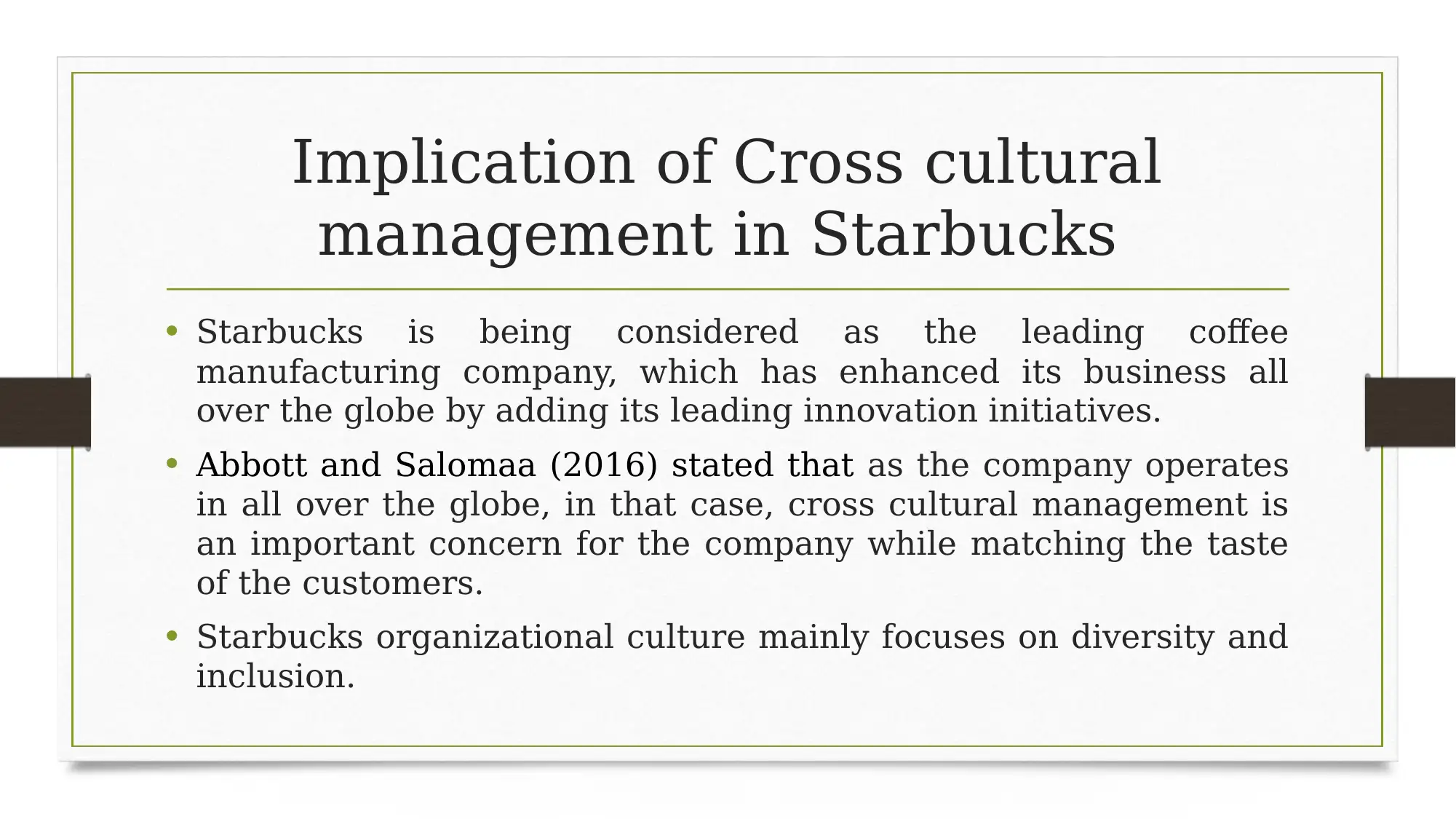
Implication of Cross cultural
management in Starbucks
• Starbucks is being considered as the leading coffee
manufacturing company, which has enhanced its business all
over the globe by adding its leading innovation initiatives.
• Abbott and Salomaa (2016) stated that as the company operates
in all over the globe, in that case, cross cultural management is
an important concern for the company while matching the taste
of the customers.
• Starbucks organizational culture mainly focuses on diversity and
inclusion.
management in Starbucks
• Starbucks is being considered as the leading coffee
manufacturing company, which has enhanced its business all
over the globe by adding its leading innovation initiatives.
• Abbott and Salomaa (2016) stated that as the company operates
in all over the globe, in that case, cross cultural management is
an important concern for the company while matching the taste
of the customers.
• Starbucks organizational culture mainly focuses on diversity and
inclusion.
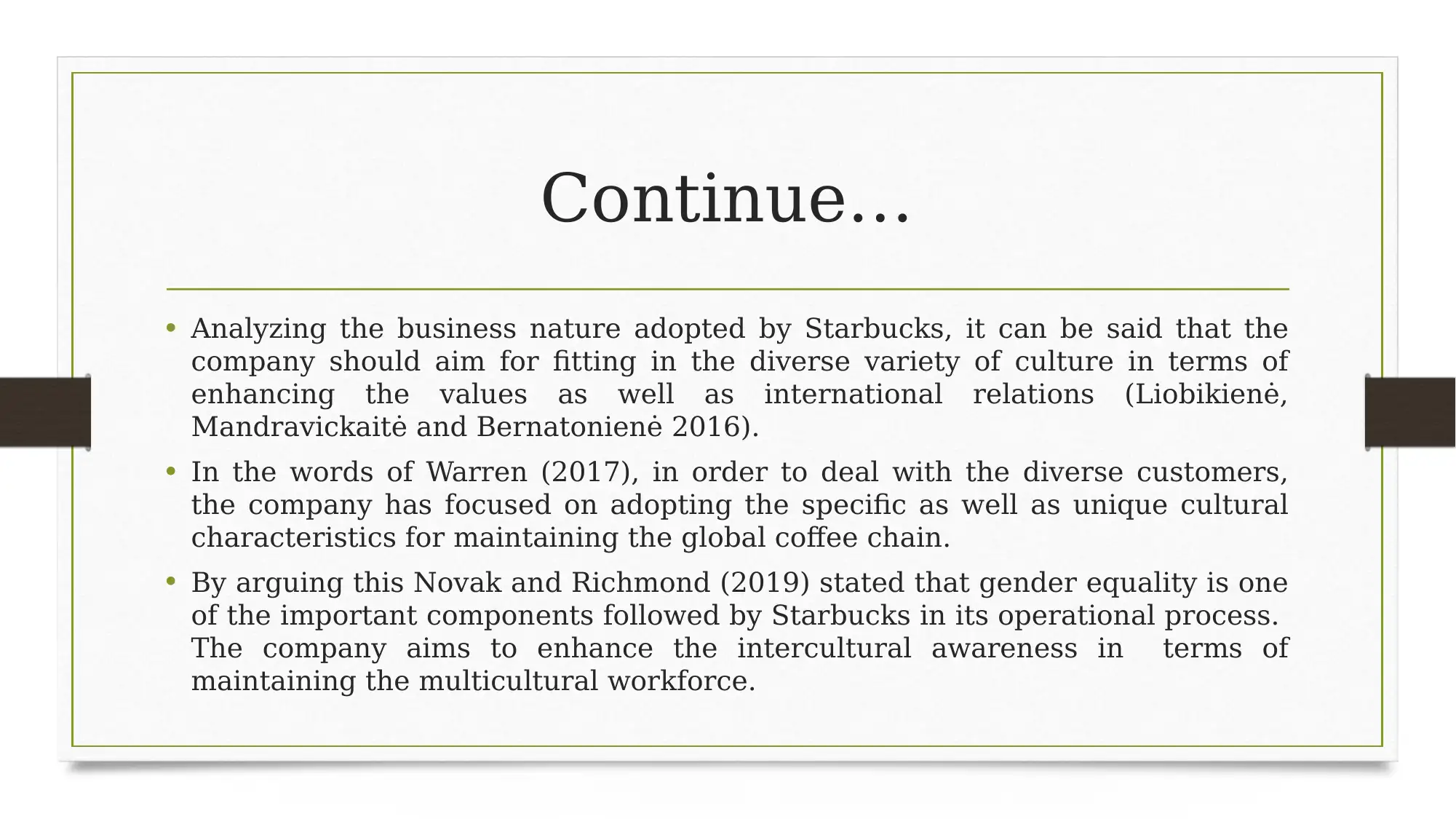
Continue…
• Analyzing the business nature adopted by Starbucks, it can be said that the
company should aim for fitting in the diverse variety of culture in terms of
enhancing the values as well as international relations (Liobikienė,
Mandravickaitė and Bernatonienė 2016).
• In the words of Warren (2017), in order to deal with the diverse customers,
the company has focused on adopting the specific as well as unique cultural
characteristics for maintaining the global coffee chain.
• By arguing this Novak and Richmond (2019) stated that gender equality is one
of the important components followed by Starbucks in its operational process.
The company aims to enhance the intercultural awareness in terms of
maintaining the multicultural workforce.
• Analyzing the business nature adopted by Starbucks, it can be said that the
company should aim for fitting in the diverse variety of culture in terms of
enhancing the values as well as international relations (Liobikienė,
Mandravickaitė and Bernatonienė 2016).
• In the words of Warren (2017), in order to deal with the diverse customers,
the company has focused on adopting the specific as well as unique cultural
characteristics for maintaining the global coffee chain.
• By arguing this Novak and Richmond (2019) stated that gender equality is one
of the important components followed by Starbucks in its operational process.
The company aims to enhance the intercultural awareness in terms of
maintaining the multicultural workforce.
⊘ This is a preview!⊘
Do you want full access?
Subscribe today to unlock all pages.

Trusted by 1+ million students worldwide
1 out of 20
Related Documents
Your All-in-One AI-Powered Toolkit for Academic Success.
+13062052269
info@desklib.com
Available 24*7 on WhatsApp / Email
![[object Object]](/_next/static/media/star-bottom.7253800d.svg)
Unlock your academic potential
Copyright © 2020–2025 A2Z Services. All Rights Reserved. Developed and managed by ZUCOL.




